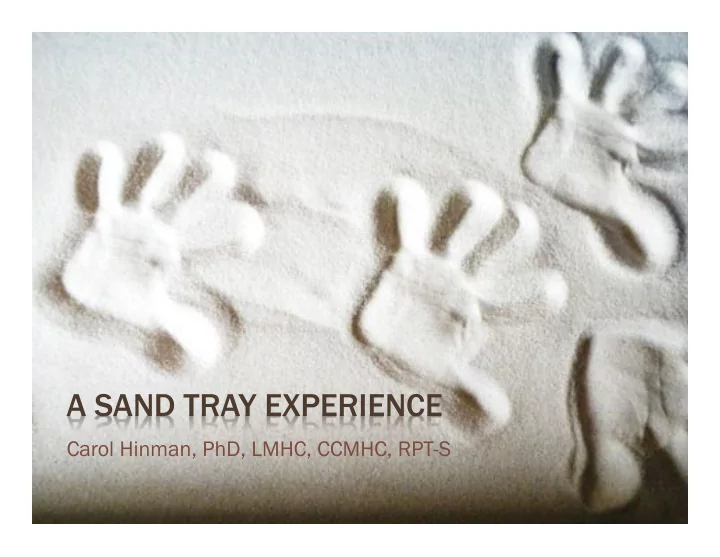

A SAND TRAY EXPERIENCE Carol Hinman, PhD, LMHC, CCMHC, RPT-S
LET’S PLAY
LET’S PROCESS
WHERE DID THAT “PULL” COME FROM? Ò Lowenfeld Ò Jungian perspective Ò Many perspectives or theories are being used with sandtray
BASICS Ò Sandtray É Traditionally rectangular 24” X 30” and 3”- 4” deep, made of wood or plastic, painted blue on the inside Ò Why? É the eye can easily visualize the entire sandtray, blue on the bottom can be seen as water, blue on the sides can be seen as sky
BASICS Ò However, É Sandtrays can be found in many sizes, shapes, and colors
BASICS Ò Sand É Traditionally, the sand used is a small grain, white sand that has been baked to kill allergens, microscopic life forms, etc. (available at ToysRUs) Ò Why? É The white sand provides a clean slate upon which the client can project their preconscious content
BASICS Ò However, É The sand that is used is widely varied in texture, color, moisture content, etc.
BASICS Ò Sandtray miniatures arrangement É displayed on narrow shelves, typically only one miniature deep Ò Why? É Each miniature is equally available to the client, taking away the arrangement of the miniatures being part of the reason a client selects a particular miniature
THE BASICS Ò However miniatures are held: É In baskets É In piles on shelves É In cupboards É In plastic containers É Under sandtrays, over sand trays, in open areas, in locked cupboards, and combinations of any and all of the above
LET’S PLAY
CREATION OF A SANDTRAY Ò Client Instructions É Hold an event, a feeling, and/or a thought in your head or your heart while É Walking through the tables and looking at the miniatures. É Pick up any miniatures that seem to speak to you or strike a chord with your thoughts or feelings and when you have as many as you need or want É Return to the sand tray and place them in (on) it.
CREATION OF A SANDTRAY Ò Counselor Instructions: É The most important thing you do while your client is building their sand tray is: BE PRESENT É After your “client’s” sandtray is built, turn over one of the papers that has questions on the back. É Because this is intended to be a simple experience, I am asking that you use only use the questions on this page and simple, reflecting statements to É 1) provide a safe environment for your “client” and É 2) help your client explore their interpretation of their sandtray.
LET’S PROCESS
LET’S PLAY
CREATION OF A SANDTRAY Ò Client Instructions É Hold an event, a feeling, and/or a thought in your head or your heart while É Walking through the tables and looking at the miniatures. É Pick up any miniatures that seem to speak to you or strike a chord with your thoughts or feelings and when you have as many as you need or want É Return to the sand tray and place them in (on) it.
CREATION OF A SANDTRAY Ò Counselor Instructions: É The most important thing you do while your client is building their sand tray is: BE PRESENT É After your “client’s” sandtray is built, turn over one of the papers that has questions on the back. É Because this is intended to be a simple experience, I am asking that you use only use the questions on this page and simple, reflecting statements to É 1) provide a safe environment for your “client” and É 2) help your client explore their interpretation of their sandtray.
LET’S PROCESS
STEPS (HOMEYER & SWEENEY, 2011) Ò 1. room preparation; Ò 2. introduction to client; Ò 3. creation of the sand tray Ò 4. post-creation processing Ò 5. sand tray cleanup Ò 6. documenting the session
THOUGHTS ? QUESTIONS ?
REFERENCES & RESOURCES FOR FUTURE EXPLORATIONS Ò Eberts, S., & Homeyer, L. (2015). Processing sand trays from two theoretical perspectives: Gestalt and Adlerian. International Journal of Play Therapy, 24(3), ppg. 134–150. [good overview of how different theoretical orientations will guide counselor’s work] Ò Homeyer, L., & Sweeney, D. (2011). Sandtray therapy: A practical manual (2nd ed.). New York, NY: Routledge.
Ò Kestly, T. A. (2016). Presence and play: Why mindfulness matters. International Journal of Play Therapy, 25(1), pps. 14–23. Ò Schadler, G., & De Domenico, G. S. (2012). Sandtray-Worldplay for people who experience chronic mental illness. International Journal of Play Therapy, 21(2), pps. 87–99. Ò Sandplay Therapists of America É http://www.sandplay.org/
Recommend
More recommend